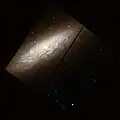| NGC 6503 | |
|---|---|
.jpg.webp) Hubble Space Telescope's Advanced Camera for Surveys displays the NGC 6503's swirling spiral arms.[1] | |
| Observation data (J2000 epoch) | |
| Constellation | Draco |
| Right ascension | 17h 49m 26.4207s[2] |
| Declination | +70° 08′ 39.587″[2] |
| Redshift | 0.000143[3] |
| Heliocentric radial velocity | 43 ± 3 km/s[3] |
| Distance | 13.05 ± 0.33 Mly (4.0 ± 0.1 Mpc)[4] |
| Apparent magnitude (V) | 10.2[5] |
| Characteristics | |
| Type | SA(s)cd[4] |
| Apparent size (V) | 7.1′ × 2.4′[4] |
| Other designations | |
| LEDA 60921, TC 575, Z 340-19, IRAS 17499+7009, 2MASX J17492651+7008396, UGC 11012, IRAS F17499+7009, MCG+12-17-009, [SLK2000] 86, ISOSS J17493+7009, PSCz Q17499+7009, WN B1750+7009, [SLK2004] 1401, K73 837, Z 1749.9+7010[3] | |
NGC 6503 is a field[6] dwarf spiral galaxy located at the edge of a region of space called the Local Void. The dwarf galaxy spans 30,000 light-years and lies approximately 17 million light-years away in the constellation of Draco (the Dragon). The spiral galaxy is especially colorful where bright red regions of gas can be seen scattered through its spiral arms. Bright blue regions contain stars that are forming. Dark brown dust areas are in the galaxy's arms and center.[7]
NGC 6503 has one known satellite galaxy, known as KK 242. With a stellar mass of about 3 million solar masses, KK 242 is on the border between a dwarf irregular galaxy (dIrr) and a dwarf spheroidal galaxy (dSph).[8]
Gallery
 NGC 6503 by Hubble Space Telescope
NGC 6503 by Hubble Space Telescope NGC 6503 (HST)
NGC 6503 (HST) NGC 6503 from Hubble.
NGC 6503 from Hubble.
References
- ↑ "NGC 6503". Retrieved 11 June 2015.
- 1 2 Brown, A. G. A.; et al. (Gaia collaboration) (August 2018). "Gaia Data Release 2: Summary of the contents and survey properties". Astronomy & Astrophysics. 616. A1. arXiv:1804.09365. Bibcode:2018A&A...616A...1G. doi:10.1051/0004-6361/201833051. Gaia DR2 record for this source at VizieR.
- 1 2 3 "SIMBAD Astronomical Database". Results for NGC 6503. Retrieved 2010-11-29.
- 1 2 3 Blanc, Guillermo A.; Weinzirl, Tim; Song, Mimi; Heiderman, Amanda; Gebhardt, Karl; Jogee, Shardha; Evans, Neal J.; Van Den Bosch, Remco C. E.; Luo, Rongxin; Drory, Niv; Fabricius, Maximilian; Fisher, David; Hao, Lei; Kaplan, Kyle; Marinova, Irina; Vutisalchavakul, Nalin; Yoachim, Peter (2013). "The Virus-P Exploration of Nearby Galaxies (Venga): Survey Design, Data Processing, and Spectral Analysis Methods". The Astronomical Journal. 145 (5): 138. arXiv:1303.1552. Bibcode:2013AJ....145..138B. doi:10.1088/0004-6256/145/5/138. S2CID 119109864.
- ↑ "The Interactive NGC Catalog Online". Results for NGC 6503. Retrieved 2010-11-29.
- ↑ Materne, J. (April 1979). "The structure of nearby groups of galaxies - Quantitative membership probabilities". Astronomy and Astrophysics. 74 (2): 235–243. Bibcode:1979A&A....74..235M.
- ↑ "HubbleSite - NewsCenter - Lonely Galaxy 'Lost in Space' (06/10/2015) - Introduction". hubblesite.org. Retrieved 2015-06-10.
- ↑ Karachentsev, Igor D.; Cannon, John M.; Fuson, Jackson; Inoue, John L.; Tully, R. Brent; Anand, Gagandeep S.; Kaisin, Serafim S. (2022). "KK 242, A Faint Companion to the Isolated SCD Galaxy NGC 6503". The Astronomical Journal. 163 (2): 51. arXiv:2111.14691. Bibcode:2022AJ....163...51K. doi:10.3847/1538-3881/ac3cbe. S2CID 244714422.
External links
Wikimedia Commons has media related to NGC 6503.
- At the Edge of the Abyss – ESA/Hubble Picture of the week.
This article is issued from Wikipedia. The text is licensed under Creative Commons - Attribution - Sharealike. Additional terms may apply for the media files.